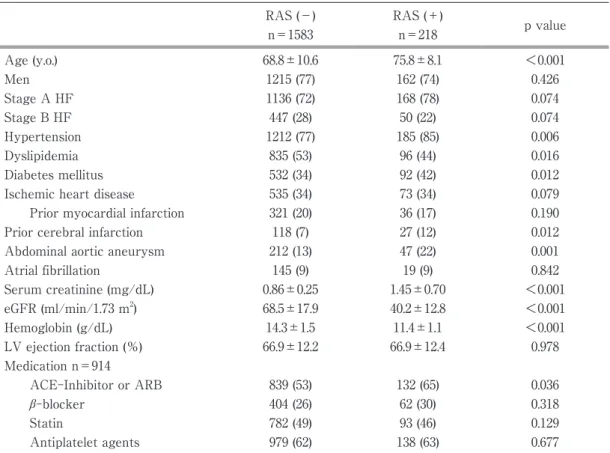Ⅰ Introduction
Currently, the rapid aging of society has caused a rapid increase in the prevalence of CHF
1)2). Though CHF in the elderly has a poor prognosis because of frequent readmission due to acute exacerbation
3), the appropriate stage or method of intervention to pre
vent worsening of CHF is unclear. Anemia and/or
CKD, known to be exacerbating factors of CHF, are often associated with that (35-57 % of patients with CHF have anemia
4)5), and 47-57 % of them have stage 3 or greater CKD
6)7)), and chronic heart failure (CHF), chronic kidney disease (CKD), and anemia are able to be caused and exacerbated by each other.
This vicious cycle named as Cardio-renal-anemia (CRA) syndrome
8)has begun to gather attention.
The interaction among CRA is complex, because each of these three conditions could be results and causes for each other, but the mechanism has been gradually elucidated. CKD and anemia activate the sympathetic system, the renin-angiotensin-aldo
Prognostic Impact of Cardio-renal-anemia Syndrome in Patients at Risk for Heart Failure from the IMPACT-ABI study
Wataru S
hoin*, Soichiro E
bisawa, Tatsuya S
aigusaTakahiro S
akai, Yasutaka O
guchi, Ayako O
kadaHirohiko M
otokiand Koichiro K
uwaharaDepartment of Cardiovascular Medicine, Shinshu University School of Medicine
Background : Cardio-renal-anemia syndrome (CRAS) is known as a vicious circle, since chronic heart failure (CHF), chronic kidney disease (CKD), and anemia are exacerbated by each other. However, it remains unclear whether CKD and anemia would be associated with cardiovascular events in asymptomatic patients at risk for HF.
Methods : We retrospectively enrolled patients without prior HF history who were hospitalized for cardiovascu
lar diseases between 2005 and 2012. Patients were divided into two groups with or without RAS defined as suffering from CKD (estimated Glomerular filtration rate (eGFR) <60 mL/min/1.73 m
2) and anemia (hemoglobin
<13 g/dL in men and <12 g/dL in women). The primary endpoint was major adverse cardiovascular events (MACE), the composite of cardio-vascular death and HF hospitalization.
Results : A total of 1801 patients were enrolled. The mean age was 69.6±10.6 years, and 76 % were men. The mean LV ejection fraction was 66.9±12.3 %, and stage A HF was present in 73 % of the patients. Over a 4.6- year median follow-up, primary endpoint was observed in 129 patients. In Kaplan-Meier analysis, patients with RAS (n=217) showed worse prognoses than those without RAS (n=1584). In multivariable Cox proportional haz
ards analysis, after the adjustment for age, sex, and conventional risk factors, RAS showed significant associa
tion with the incidence of MACE (HR 1.86 ; 95 % CI 1.20-2.89, P=0.005).
Conclusions : In patients at risk for HF, RAS was significantly associated with future cardiovascular events.
Investigation of the impact of early intervention for preventing CKD and anemia on those patientsʼ prognosis is warranted. Shinshu Med J 68 : 139―147, 2020
(Received for publication January 7, 2020 ; accepted in revised form February 5, 2020) Key words : cardio-renal-anemia syndrome, heart failure, chronic kidney disease, anemia
* Corresponding author : Wataru Shoin Department of Cardiovascular Medicine, Shinshu University School of Medicine, 3-1-1 Asahi, Matsumoto, Nagano 390-8621, Japan E-mail : wshoin@shinshu-u.ac.jp

